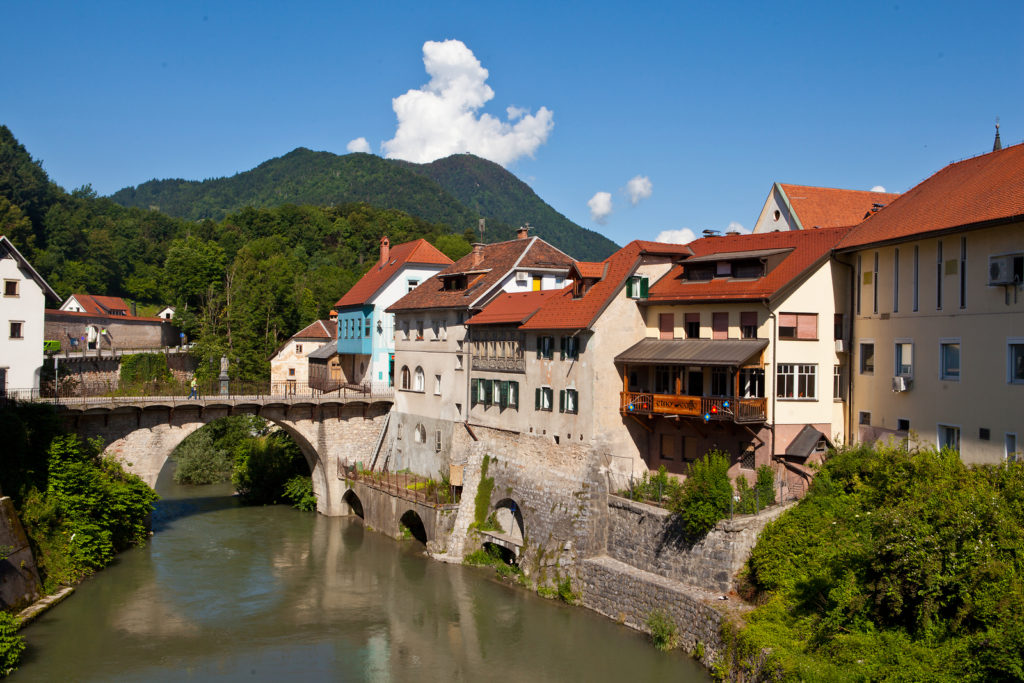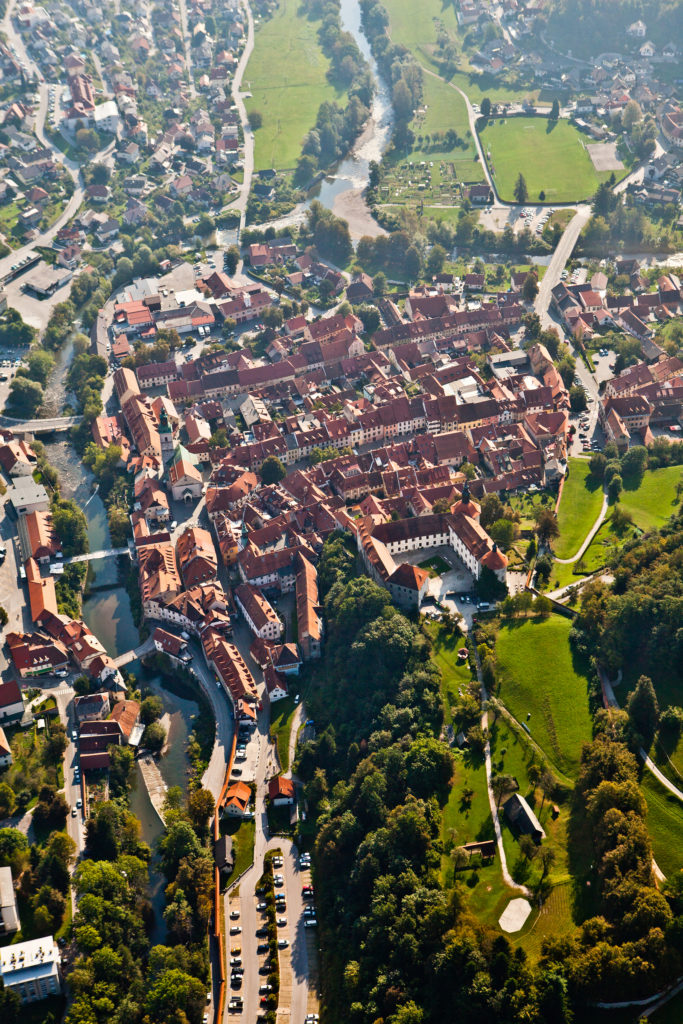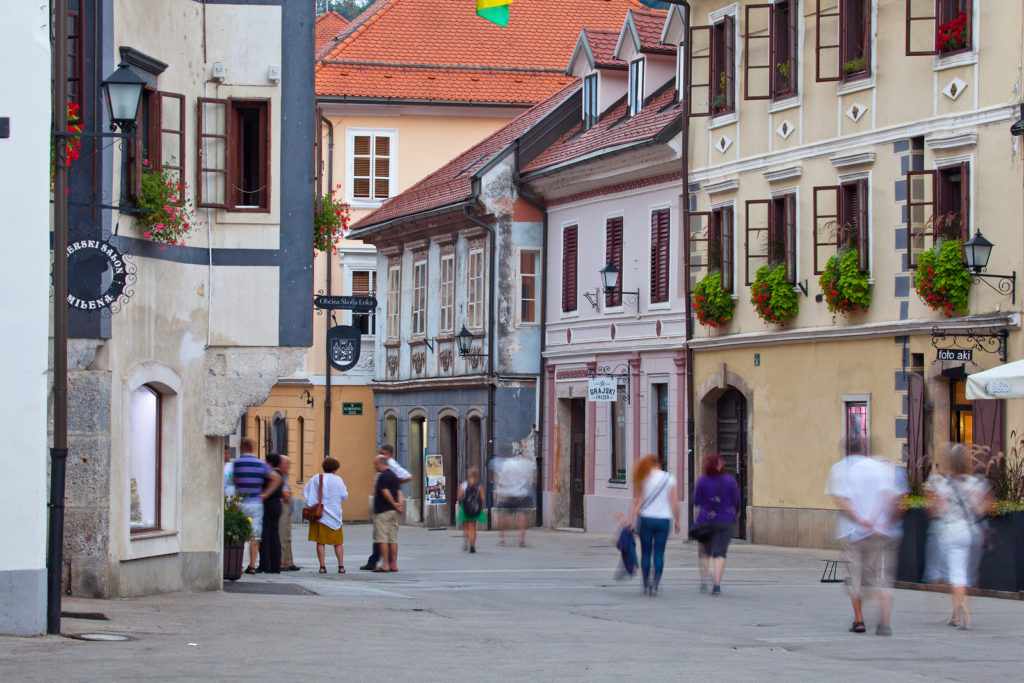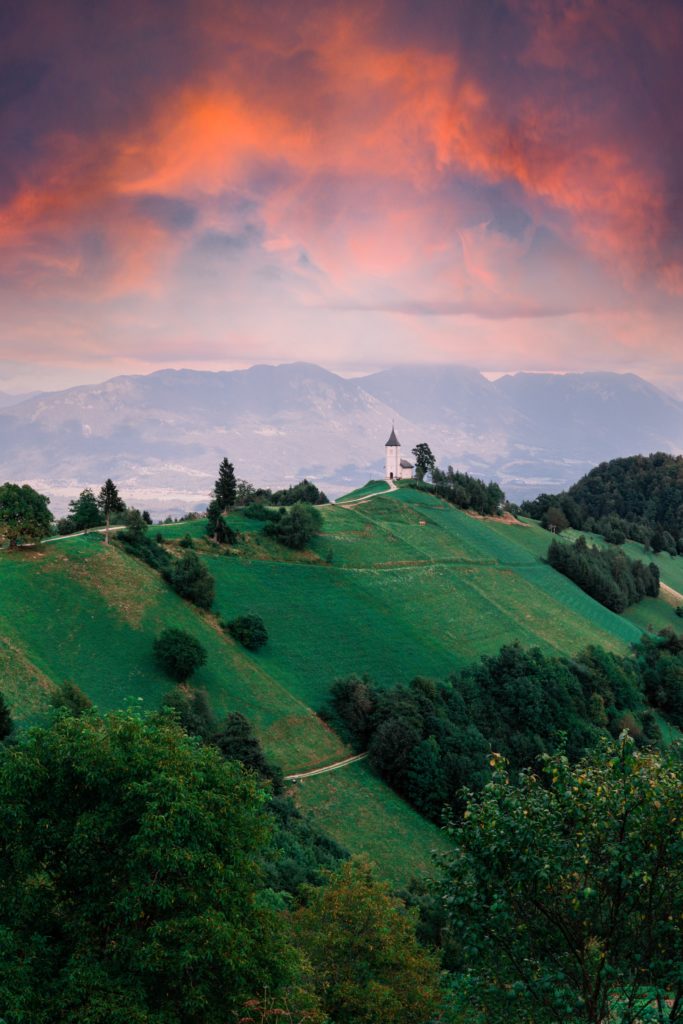Follow this route that takes in a fabulous church, a stunning communist monument, a good restaurant, a secret viewpoint and an old village.
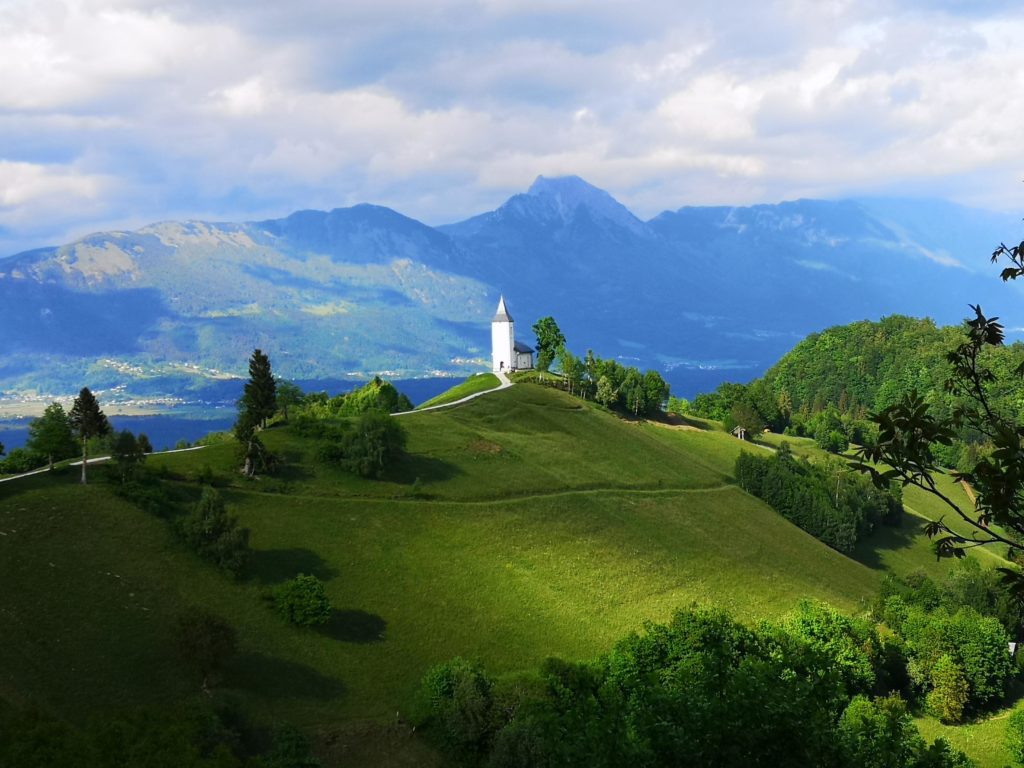
Jamnik is a church known to all professional Slovenian photographers. They come here in all weathers and all seasons to photograph this white church set on a hill with the mountains as a backdrop.
This church is slowly beginning to emerge on Instagram, but remains off the beaten track
In this article, you’ll find out how to get to the church easily and, more importantly, how to fit it into a beautiful day’s holiday. I spent three days exploring the surrounding area, testing out hikes and restaurants in this part of Slovenia to find some really beautiful spots. Not far from the church, in particular, there’s a monumental communist memorial building that stands out in this beautiful Slovenian countryside and won’t leave you indifferent.
Right next to this religious building, there is a secret panoramic viewpoint on a rocky spur that is as little-known as it is spectacular (description and location at the end of the article).
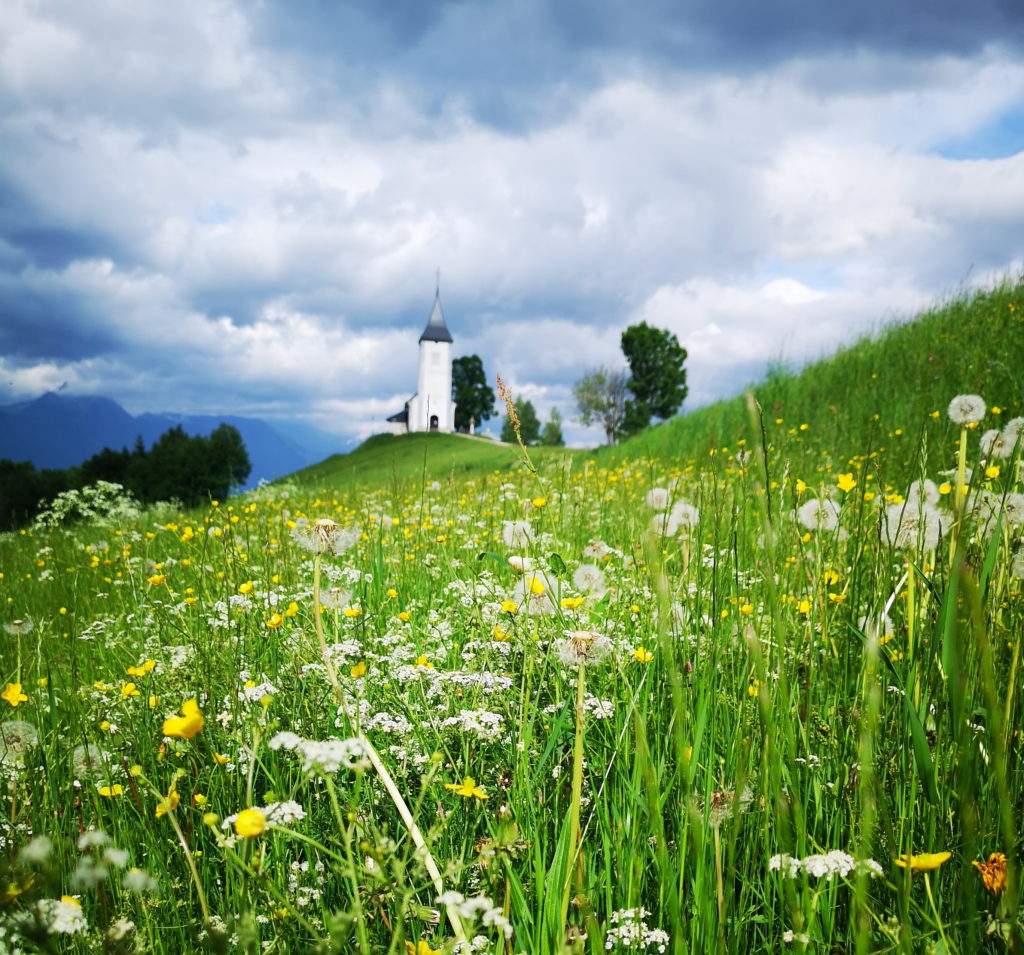
The church is located on a small road between Lake Bled and Ljubljana.
According to the travel philosophy I’m trying to propose in this guide, the church of Jamnik shouldn’t take up a day or an afternoon of your time, but should be added to your holiday programme along with other visits.
Remember: in Slovenia, distances are short and it’s easy to combine some great attractions in the same day.
The little church from the air
First you’ll see the church, then a little further on this astonishing concrete communist monument.
Jamnik lies between Lake Bled and Ljubljana
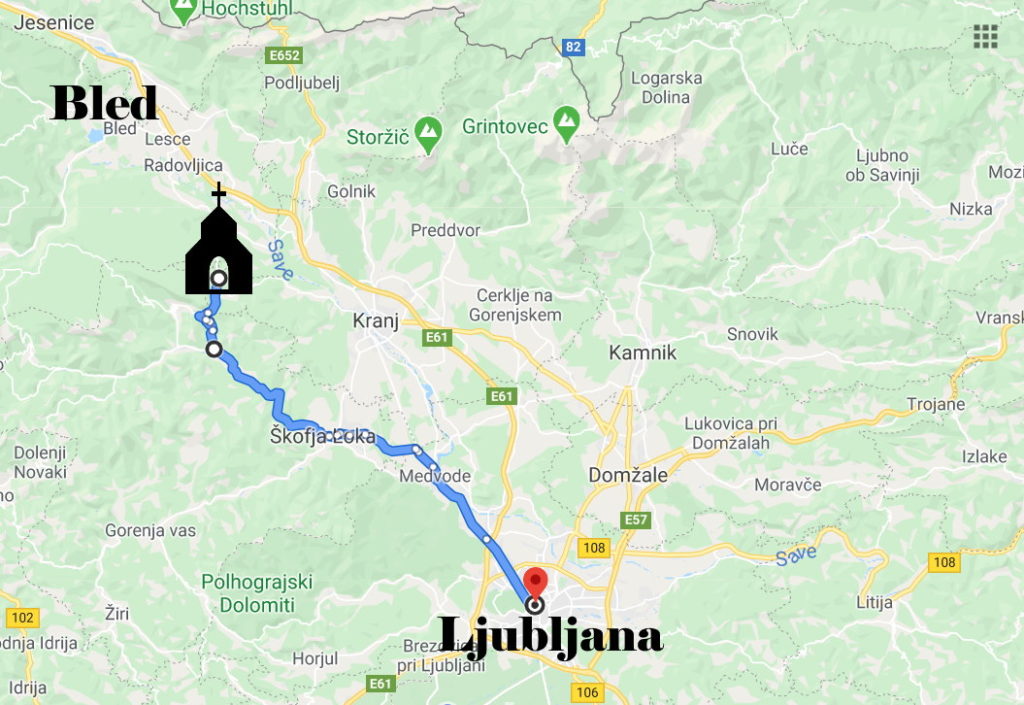
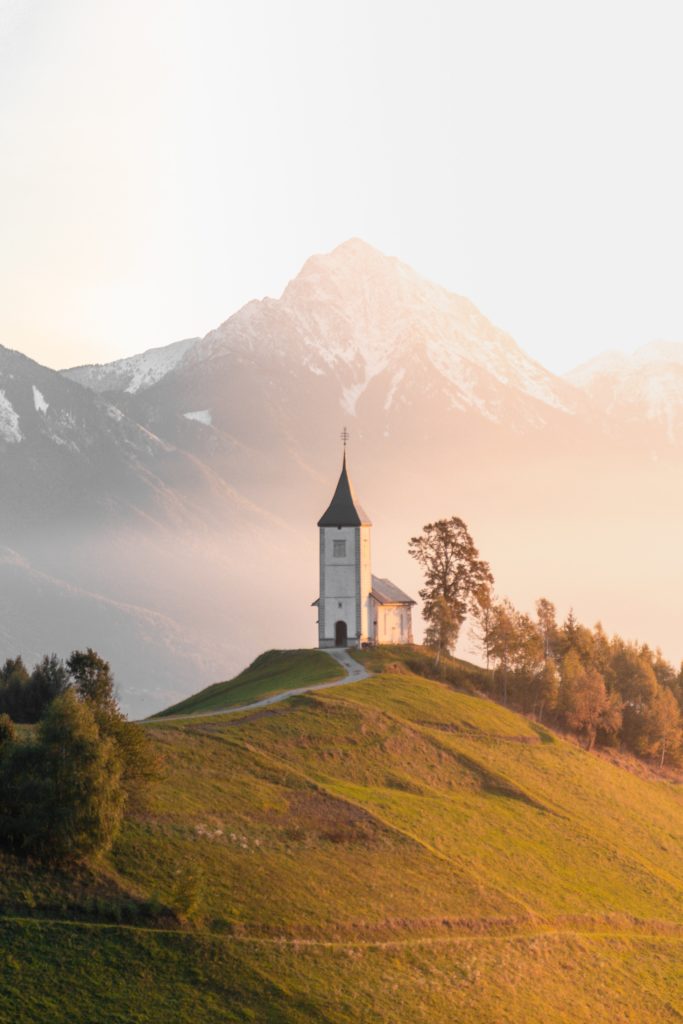
- Lake Bled – Jamnik: 30 min – 20 km
- Lake Bohinj – Jamnik: 1h10 – 43 km (well-maintained gravel road) or 52 km
- Ljubljana – Jamnik: 55 min – 52 km
Note: If you decide to make the journey between Ljubljana and Lake Bled, taking a diversion via the Jamnik church and the Drazgosce monument, allow around 50 minutes extra driving time to get back to Ljubljana.
Places to park
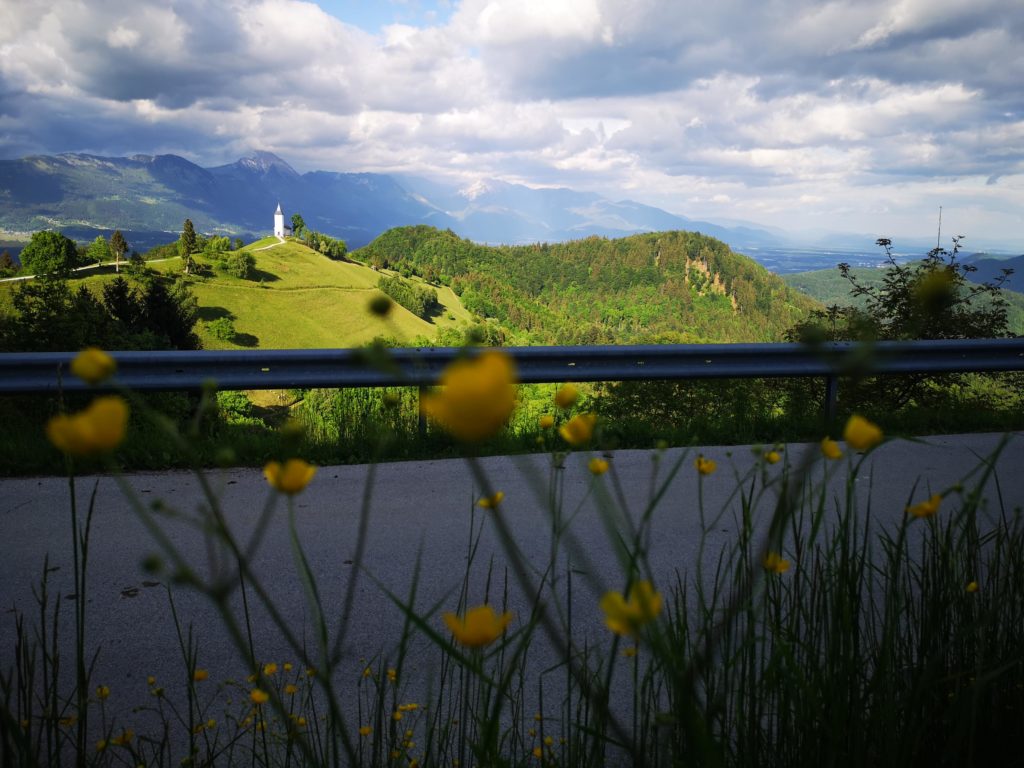
Despite the bright and picturesque scene, Jamnik remains off the beaten track. There is no large car park for tourists and only a dozen or so spaces scattered along the road. If the spaces are taken, don’t go down into the small village of Jamnik to find a spot, as there aren’t any. Continue along the road to find a parking space and then walk back to the church.
Walking to the church of Saint Primus and Felician (Jamnik)
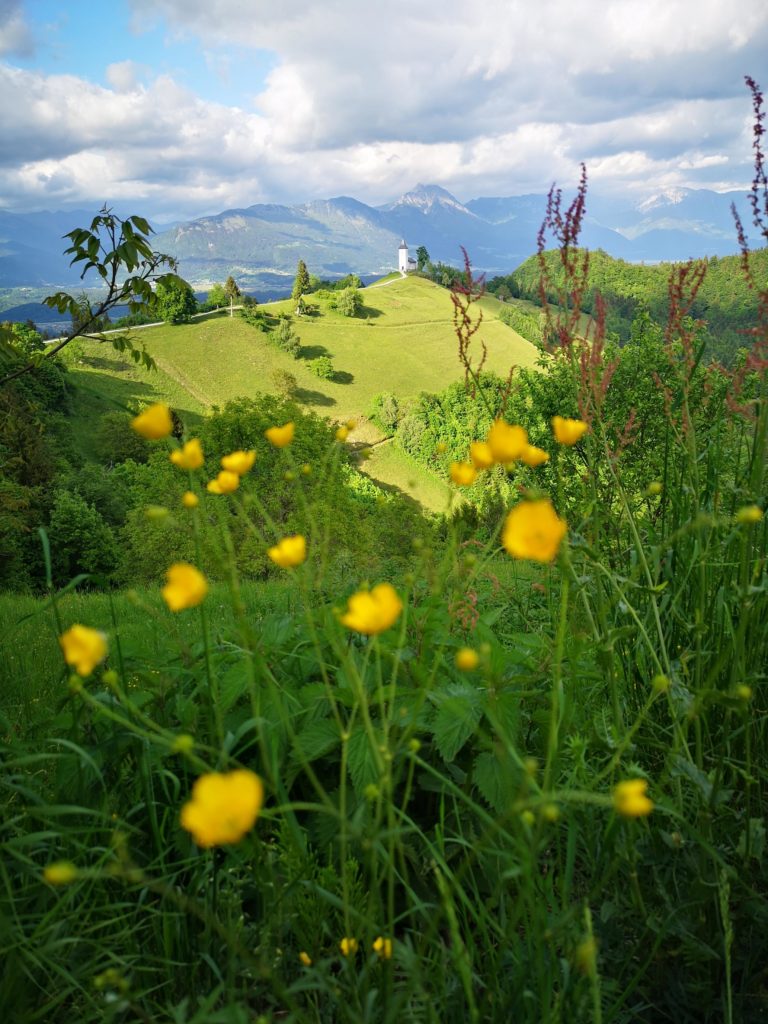
Once you’ve parked, there‘s no problem, and the good news for those who don’t like walking is that there’s no big sweat on the agenda: 400 m of flat walking on the outward journey and you’re at the church. You start by descending some large wooden and earthen steps before joining a flat path. Once you’ve reached the church, you can admire the entire valley stretching from the capital Ljubljana to Lake Bled.
This view of the beautiful mountains is remarkable , and you’ll see three hikes in particular that you might decide to do during your stay if they seem attractive from a distance (Dobrca, Kriska Gora and Stol).
Tip: There’s a sign on site with a panoramic photo to help you spot the summits of these hikes.
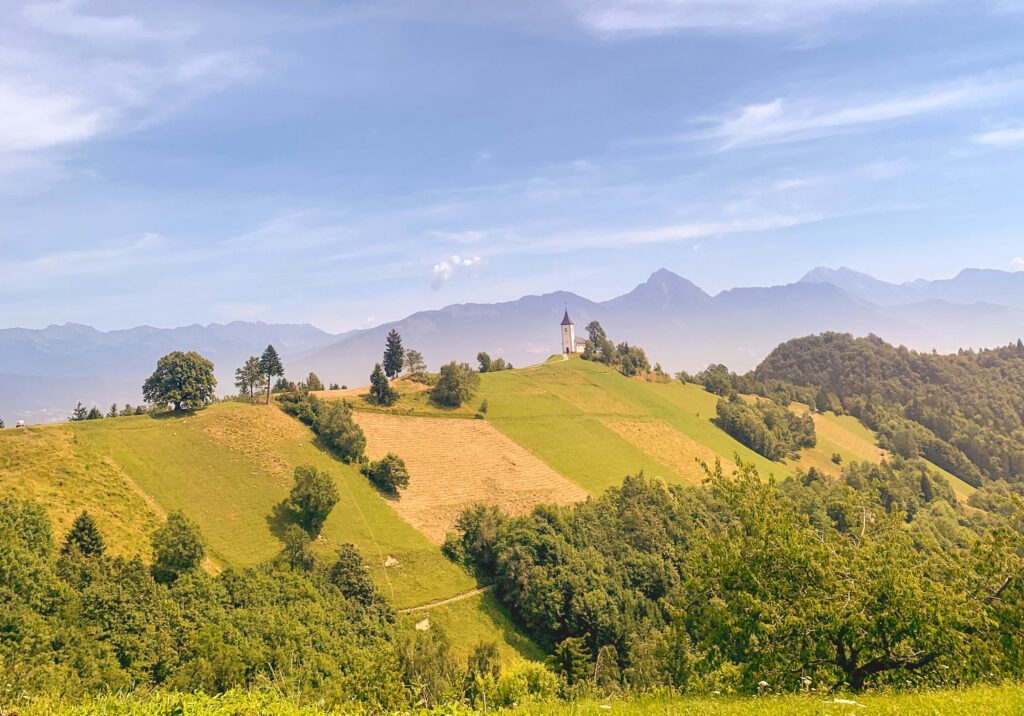
Because of its exceptional panoramic view, the church was used as an observation point during the Turkish invasions.
The church will be closed: I’ve never been able to get through the door, but I don’t think it’s much more interesting than any other of the hundreds of churches in Slovenia. On site, you’ll find a panel detailing the history of the church. There has been a church building on this hill since 1501.
The best places to take your photo of Jamnik church
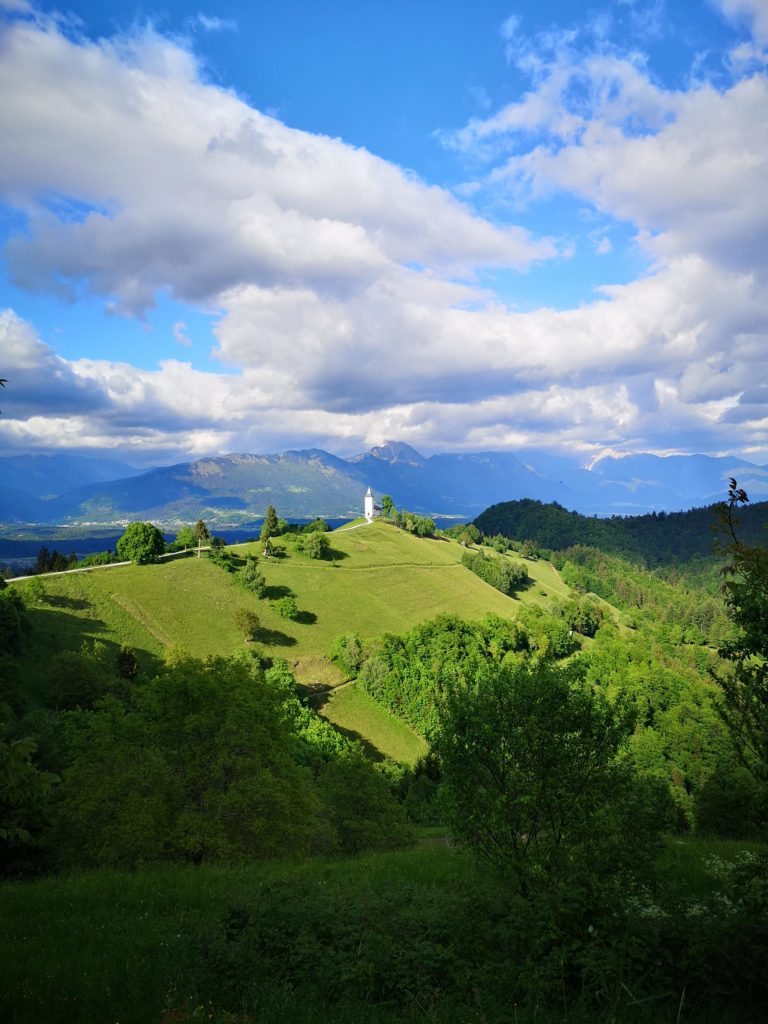
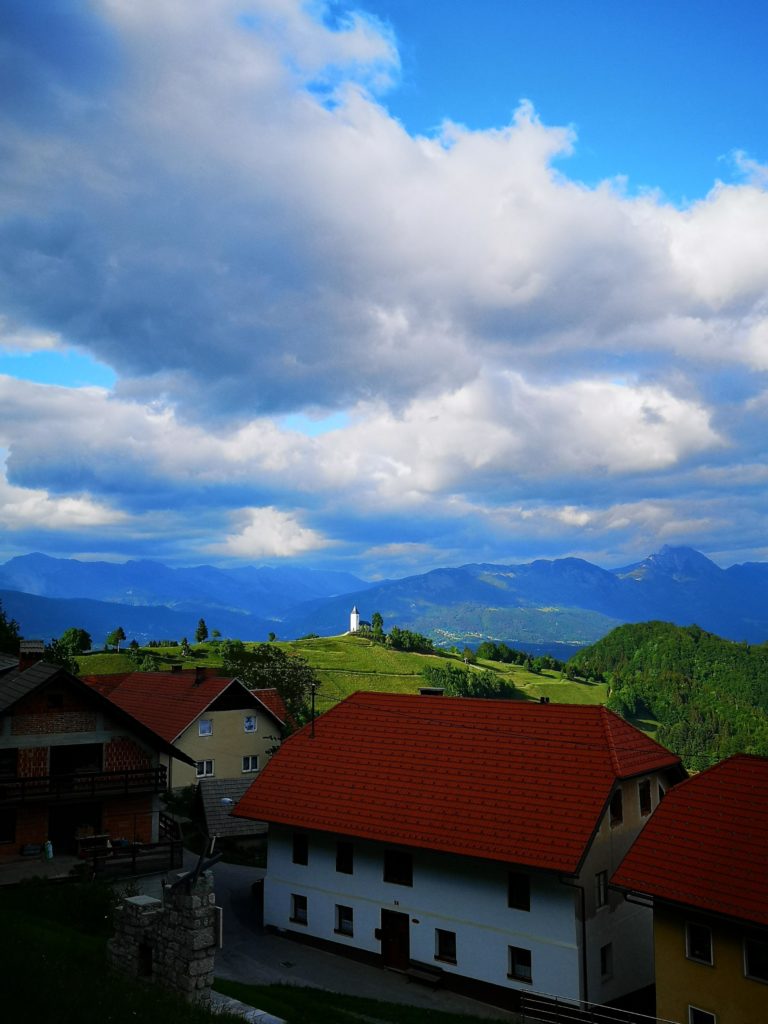
The view from the car park is nice, but it’s not the best you can get. There are two viewpoints you’ll need to get to if you want to get some great shots. You’ll find them on the map below; walk to them.
Map to help you find your way around
The village of Kropa
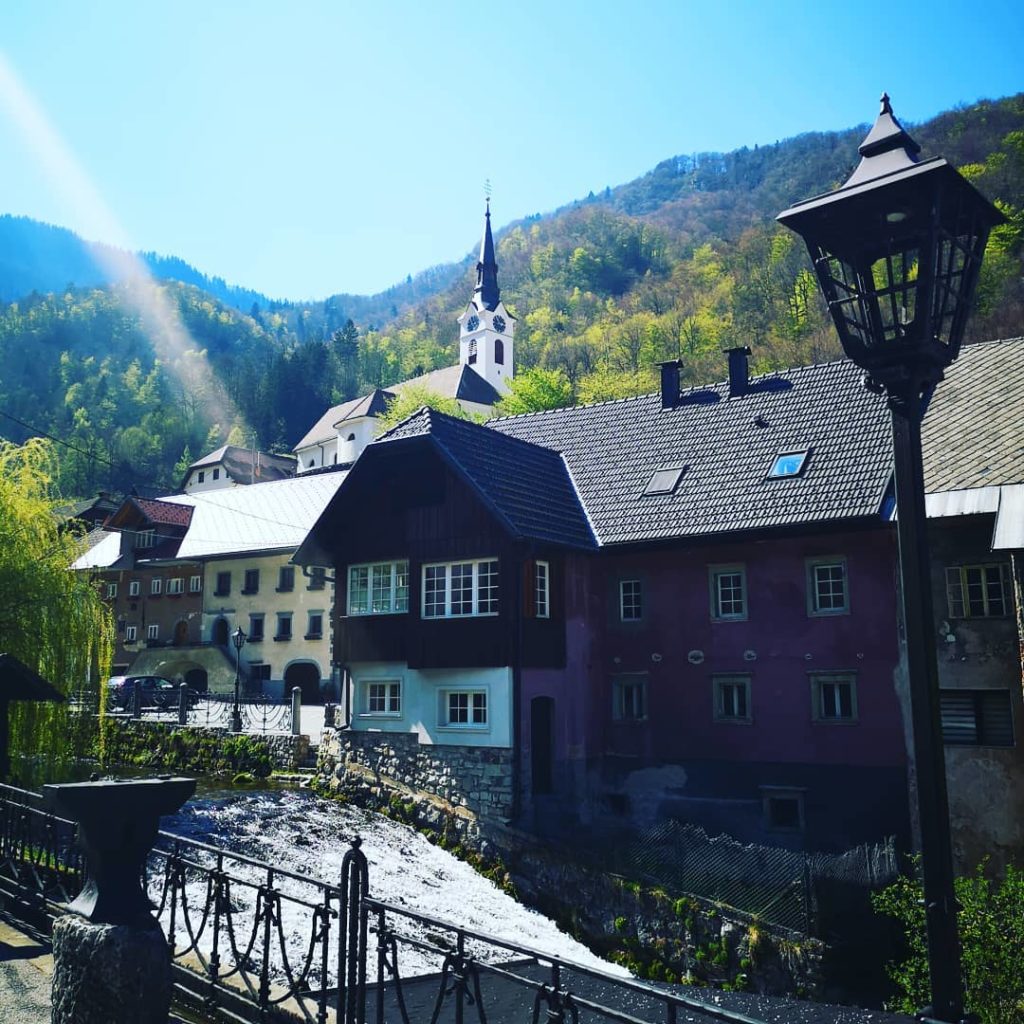
Along the way, you’re bound to pass through Kropa, a village surrounded by hills. I explored it from top to bottom. The verdict is that it’s not the most beautiful village in Slovenia, but it’s an original one, and as it’ll be on your route, take a short break by parking in the small square in the centre of the village (here). Take a few minutes to walk along the small river that runs between the large old buildings, admire the communist statue and stroll through some of the village streets.
A museum is dedicated to the town’s industrial past and its specialisation in the manufacture of 120 different types of nail between the 15th and 19th centuries: it’s the “nail museum” as a friend calls it. Living here, I found it interesting, but I’m afraid you won’t (admission €5).
You can also visit the forge and take part in a demonstration with your own hammer (make an appointment – museum website ). You’ll probably enjoy Jamnik and the other attractions in this article much more, so don’t hang around the village too long.
Eating out : In the village, I recommend the Gostilna Pr’ Kovač restaurant. Very typical, it serves traditional Slovenian dishes.
Gostilna Pr’ Kovač. address: Kropa 30, 4245 Kropa
Tip: There is a beautiful outdoor swimming pool in the countryside just before the entrance to the village. It has a real holiday atmosphere. Don’t forget to bring your swimming costume and take a dip if it’s very hot. The pool’s website is here. Admission €7.
The village pizzeria : Kropa’s traditional restaurant, Gostilna Pri Jarmu Kropa, is another good address where the food is very good. If you’re hungry, make a stop here.
Gostilna Pri Jarmu: Kropa 2, 4245 Kropa
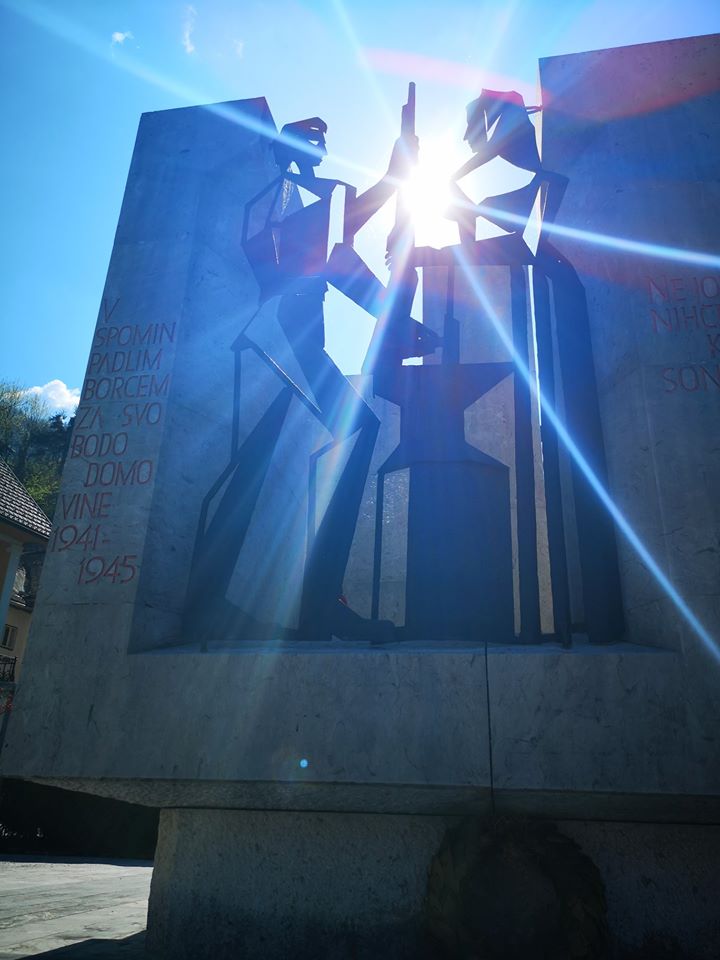
The Second World War monument
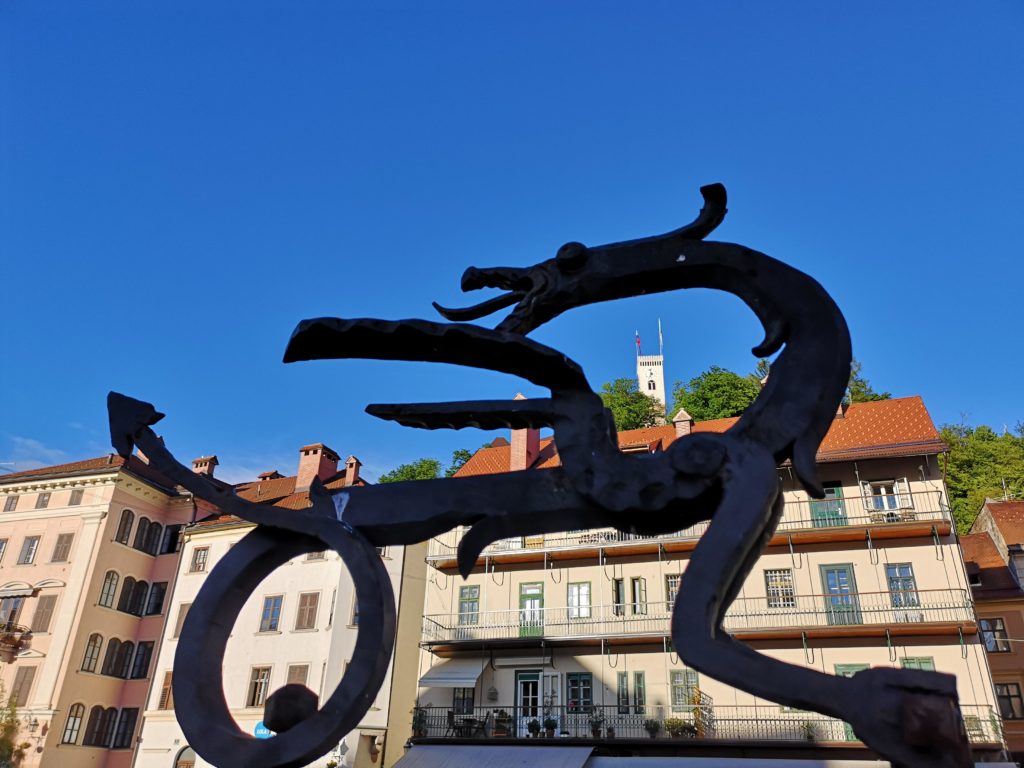
A little detail: these wrought-iron dragons that you will see in Ljubljana, by the river, come from the forges in the village of Kropa.
Dražgoše, a stunning Communist monument set in the landscape
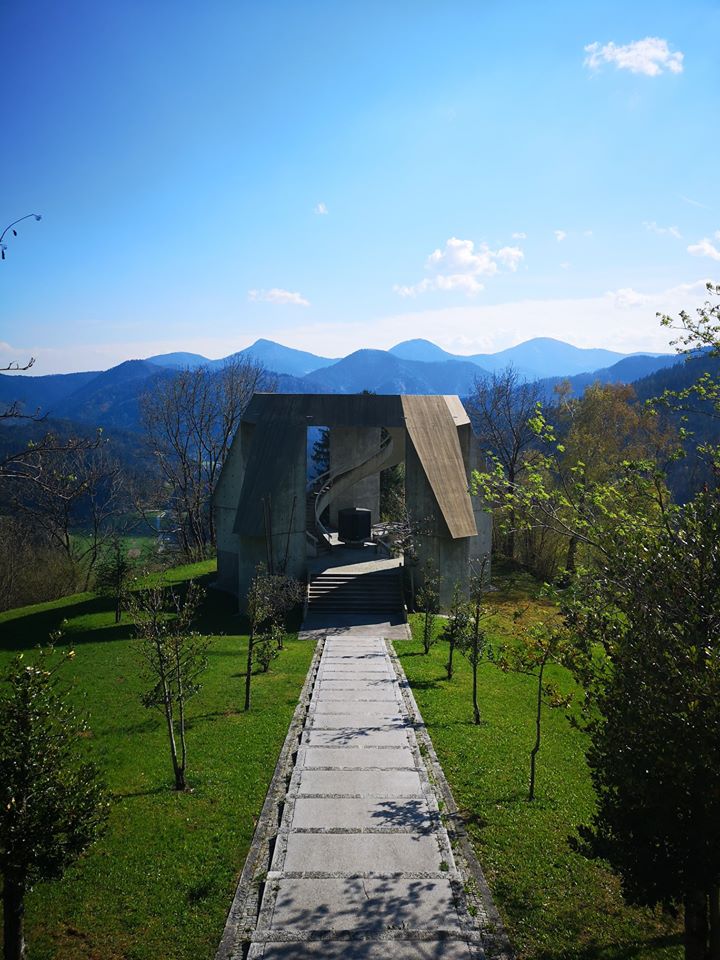
While exploring the area in depth by car and mountain bike, I spotted another attraction a few kilometres from the church. It’s a cement building in the communist architectural style, whose impromptu positioning in the panorama is bound to surprise you. It’s almost a square, measuring 12m by 13m. Why is it there? It commemorates a famous battle.
The history of this battle
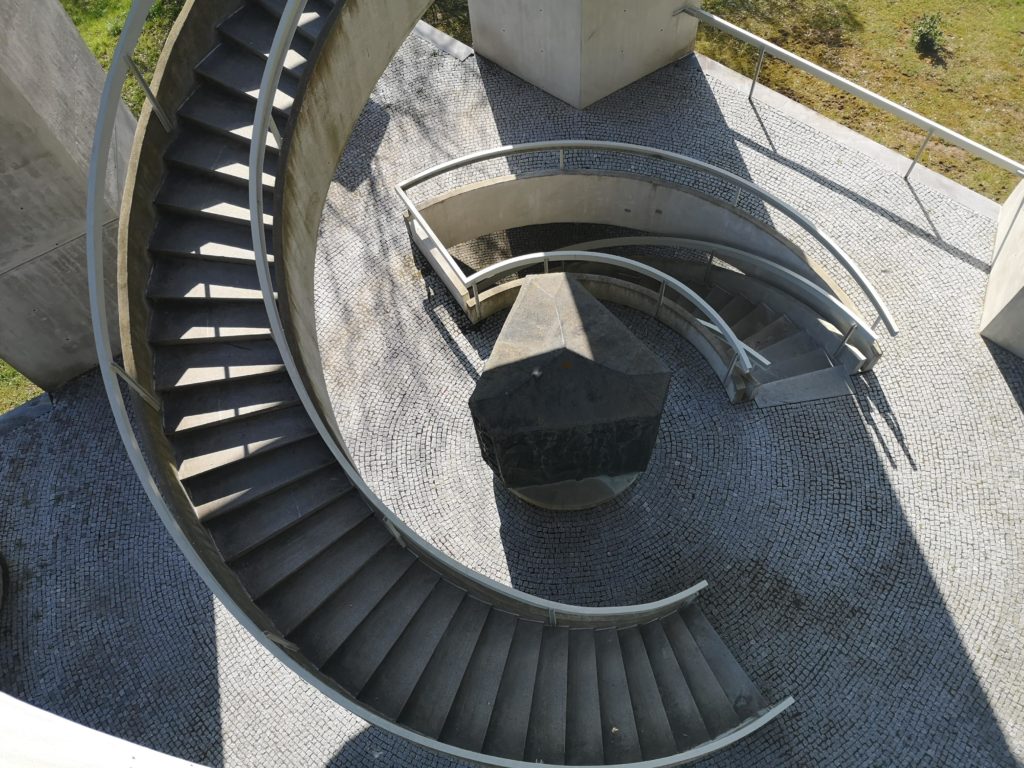
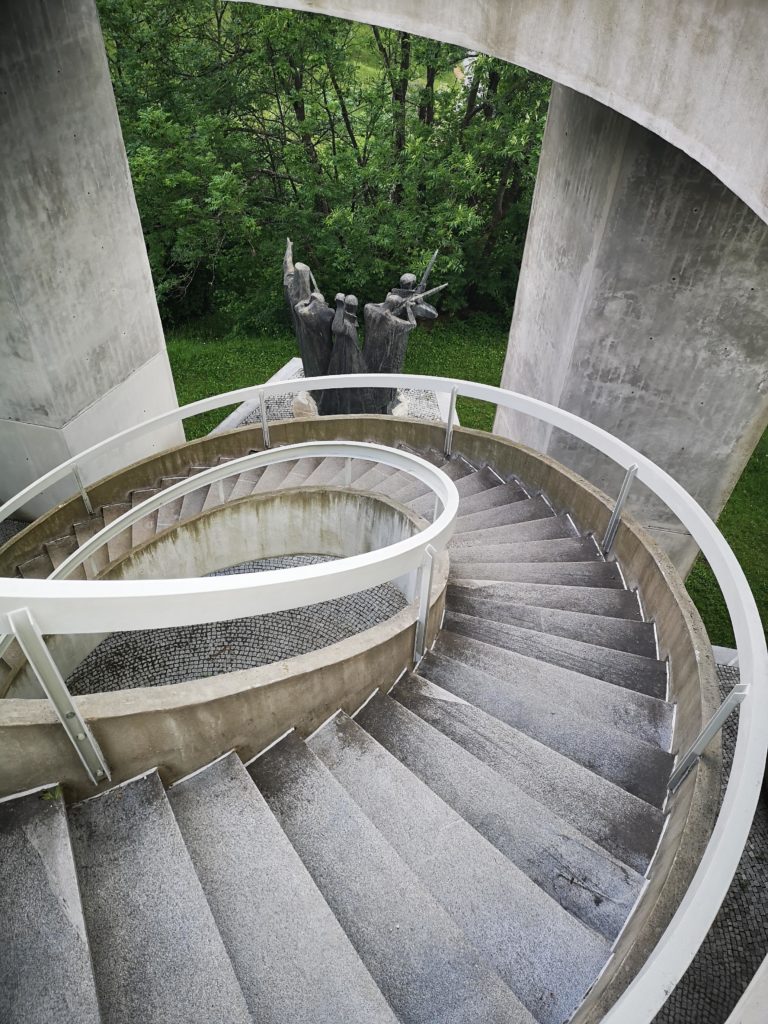
Note : If history isn’t your cup of tea, skip ahead to the next paragraph on the extraordinary panoramic view.
Before I give you the location of the secret panoramic viewpoint, a bit of history. This monument was built in honour of the Cankar Battalion, a Yugoslav communist resistance battalion called the Partisans, which fought against the Germans in 1942 in these snowy hills. It was the first major battle between the two armies. Nearly 2,500 German soldiers approached the village to deport the villagers. A battalion of 208 Partizans tried to stop them.
The battle began in the dead of winter on 9 January and lasted three days in thick snow and freezing temperatures.
Not only were the Germans outnumbered at least ten to one, they were also much better armed. In particular, the partisans used a rocky spur to fire at the Germans from a high point. It’s this secret spur that you’ll reach later to enjoy a superb view over the valley, which is why you can still see a red star there today. Unable to hold the position any longer, the partisans took refuge in the mountains after three days. The outcome of the battle: 9 partisans killed. The Germans then launched a punitive operation, shooting 41 inhabitants as soon as the battle was over and burning the village the following month.
The construction of the memorial (a spomenik)
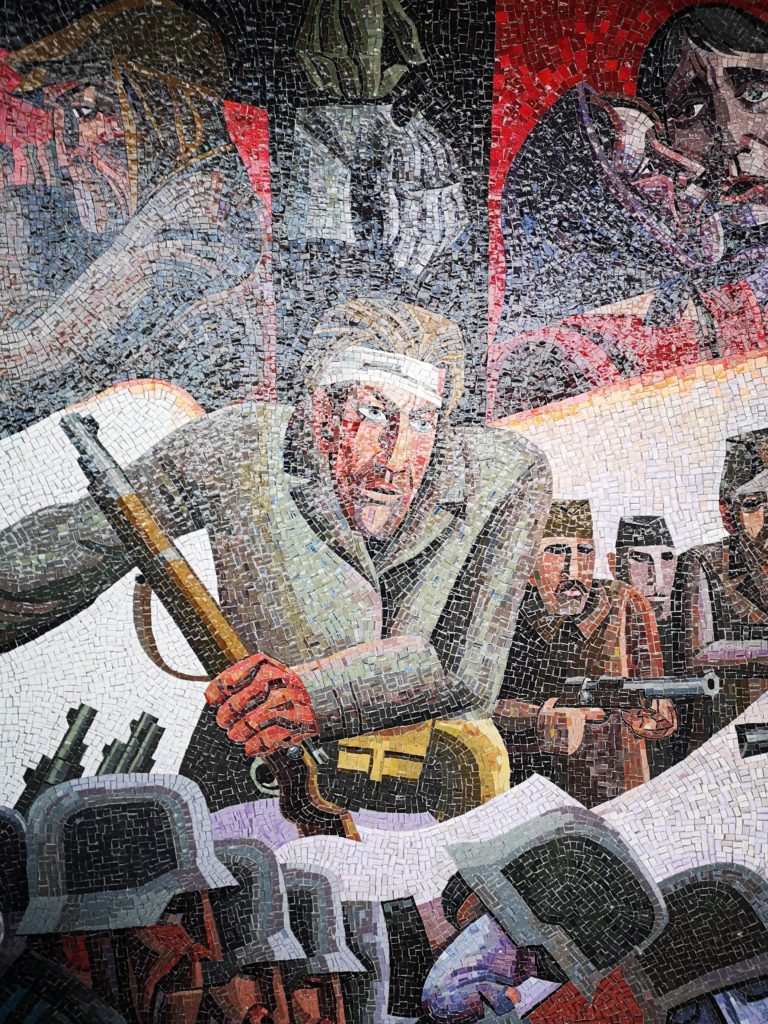
For years, various governments had wanted a monument to commemorate the battle, but nothing had been done. In 1974, a competition was organised, inviting the four leading Slovenian architects. Two criteria had to be met: the building had to be able to draw crowds for the celebrations, and it had to provide a view of the battlefield. This second requirement will come in very handy during your holiday, as you will be able to enjoy a beautiful view from the top of this strange building. The building took a year to complete and was inaugurated in May 1977.
Did you know ? There are many spomenik in the former Yugoslavia. They are listed on this excellent website.
3-bedroom house deal: From the village of Drazgose, the view is extraordinary and I’ve seen that it’s possible to stay in one of the houses in the village and take advantage of this incredible view. I highly recommend it if you have a car and want to spend a relaxing holiday in beautiful authentic Slovenian accommodation (max for 3 days).
The secret panoramic view
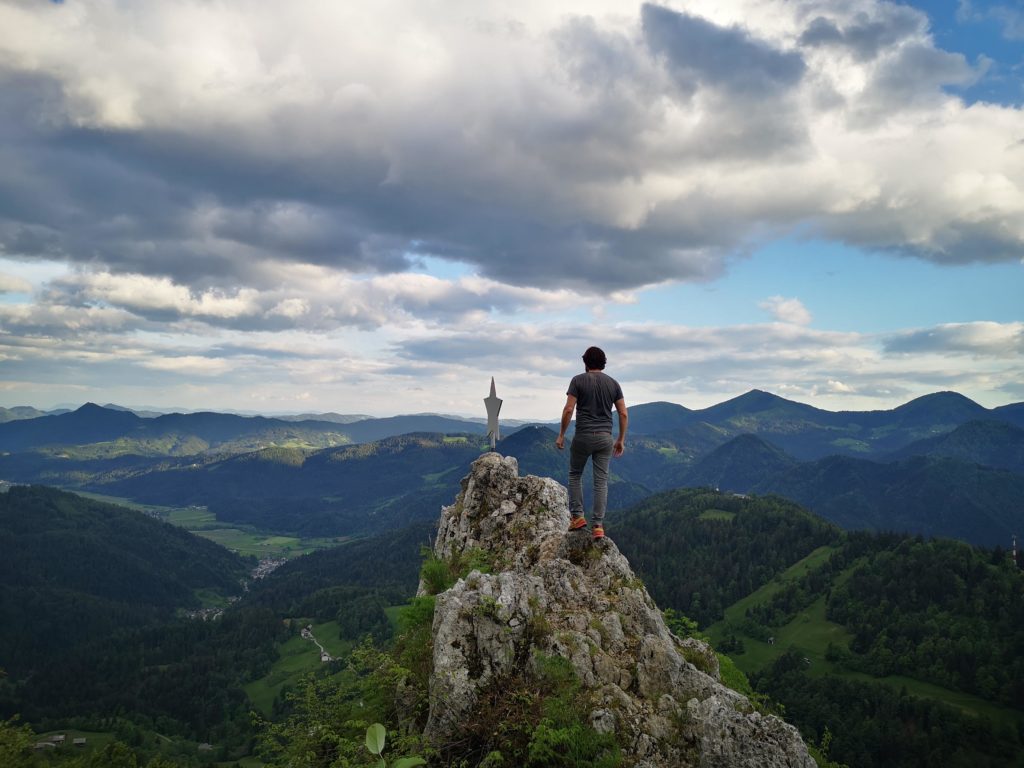
On the heights of the village of Dražgoše, there is a secret spot with an incredible open view over the whole valley. It’s a strategic spot where the partisans had positioned themselves, and once you’re there, you’ll understand why. This prominent rocky spur dominates the valley and offers a very open panoramic view. A truly secret spot, I had a bit of trouble finding the right road to get there, but you won’t either.
Getting there : Drive slowly near the finish and park in the gravel car park. From the car park, you’ll see a sign for Bickova Skala 0.5 km. Walk up the road and a few minutes later you’ll be there.
Guidance with Google Maps: Click here.
You’ll have the chance to take a great Instagram photo. I haven’t seen anyone do it yet. If you take the same photo as I did, I recommend not tagging the exact location (put Slovenia for example). There aren’t too many readers of this blog and that’s fine, but if the photo spreads on Instagram and is reproduced identically hundreds of times, as often happens, the road will be too small for traffic, it will become dangerous and it will be hell for the residents who live next door. It took me 12 years to find this place and out of respect for the gentle daily lives of local residents, I’d like to thank you for not revealing the exact location on Instagram.
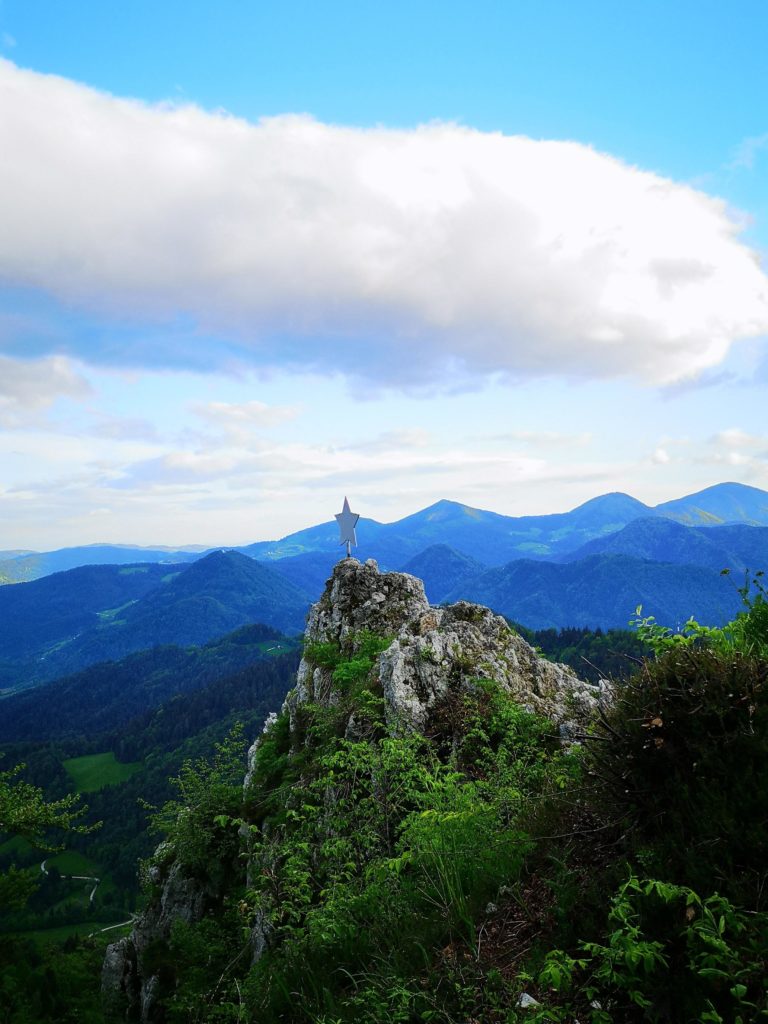
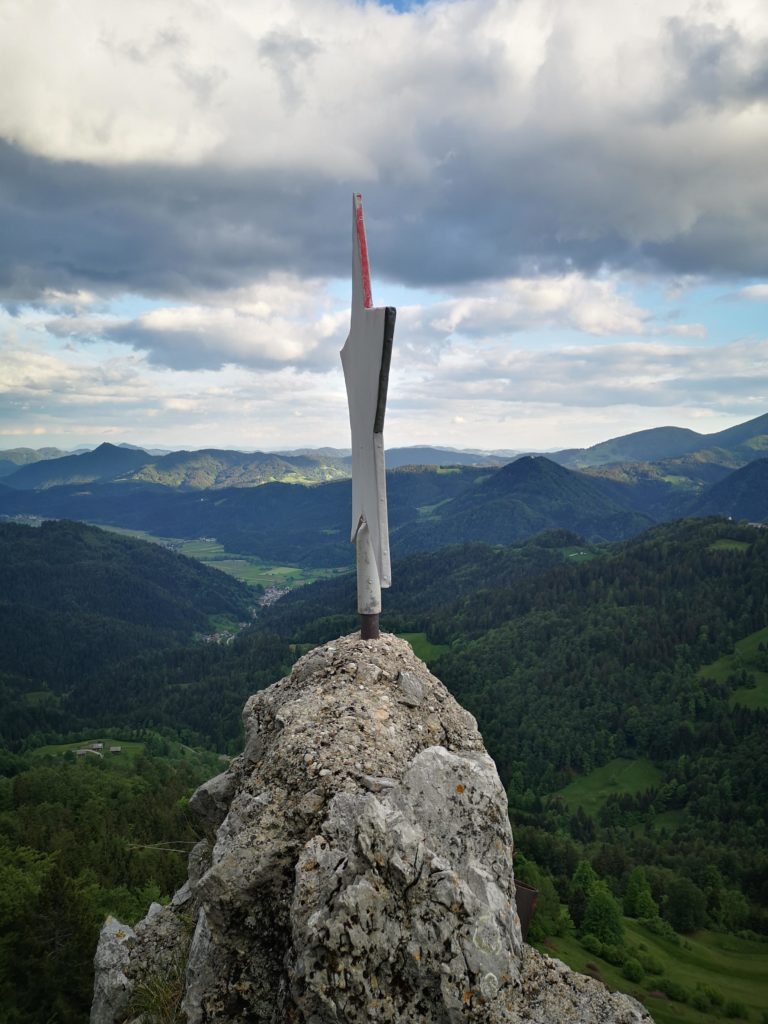
Where to eat in the area
In Slovenia, when you’re out in the countryside, you always have to stop somewhere for a bite to eat. It’s usually good, traditional and cheap. Restaurants are open all afternoon. I tried out several restaurants in the area and selected two places with panoramic views where you’ll feel good and eat well for cheap.
La Brunarica Dražgoše
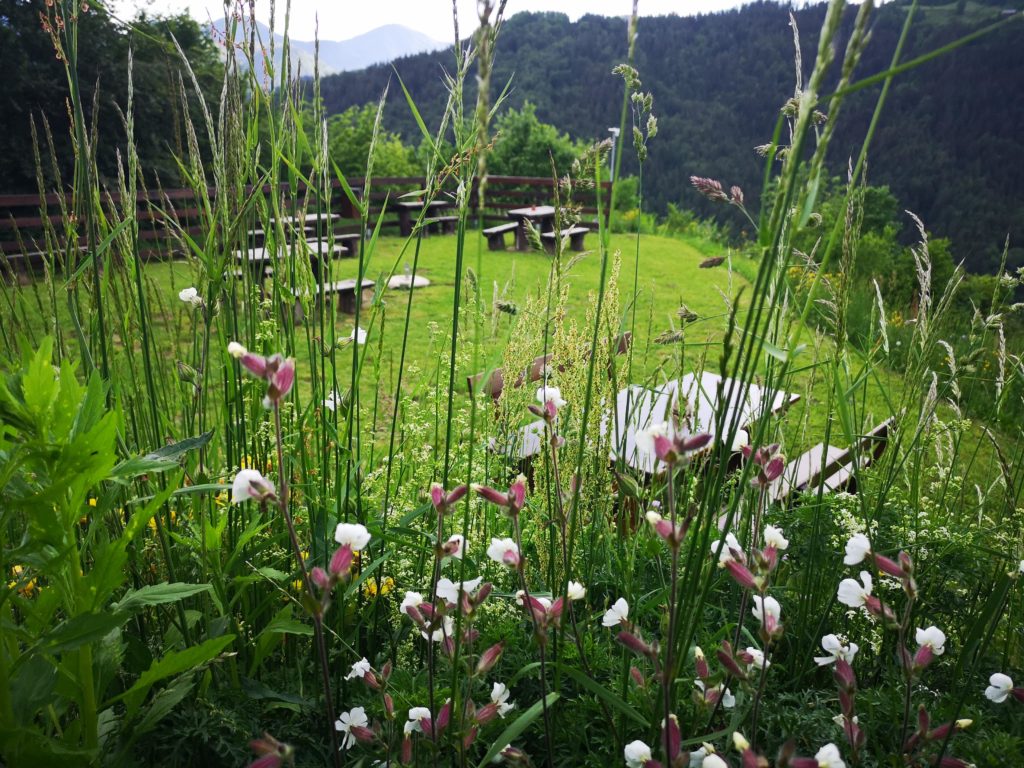
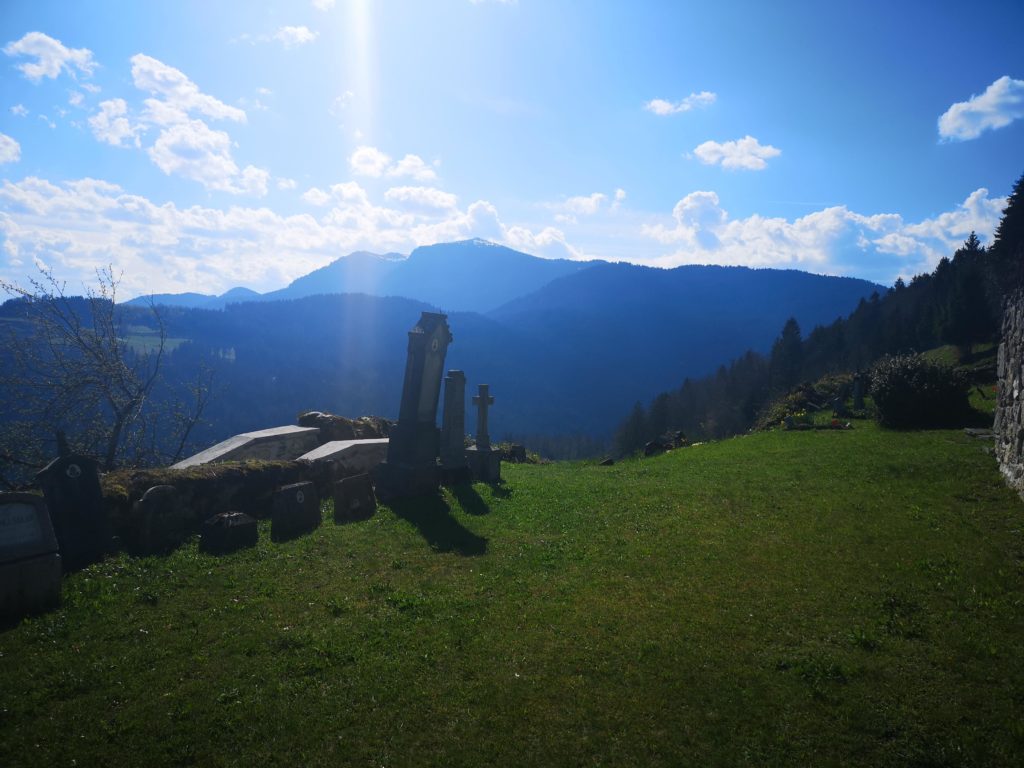
A simple little restaurant located right next to the communist monument. Tight prices: cappuccino for €2, half-litre of beer for €3, litre of wine in a carafe for €10. It serves traditional Slovenian dishes such as hearty soups and well-stocked plates for between €8 and €12. There are also pizzas. Simple, hearty and inexpensive. A la bonne franquette. Enjoy it either on the covered terrace or on the large wooden tables in the small garden with a view. You’ll really feel at home here, and get a taste of authentic Slovenia. The restaurant also serves desserts. No matter what time of day you visit, stop in for a coffee, a decilitre of wine, a dessert, lunch or even dinner on a summer’s evening.
Short walk: If you want to stretch your legs, walk 5 minutes to the modern Sveta Lucije church next door, I think the fresco inside is pretty good (but it’s by no means a must-see). I noticed that the church isn’t always open.
La gostilan Pri Bostjanu
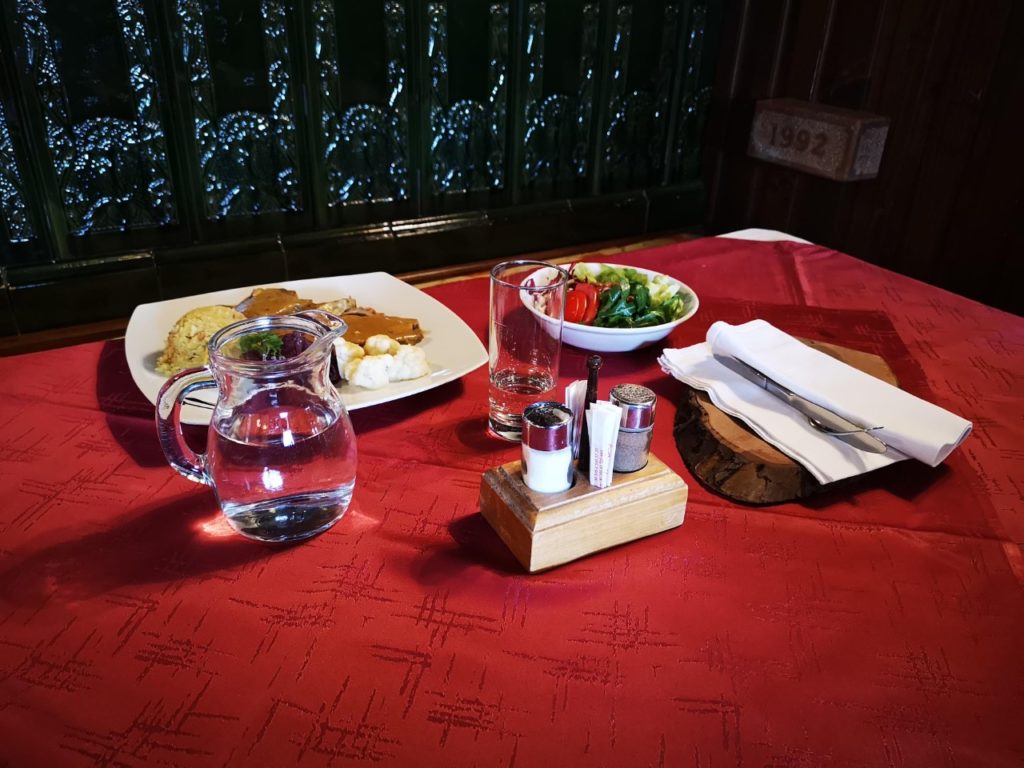
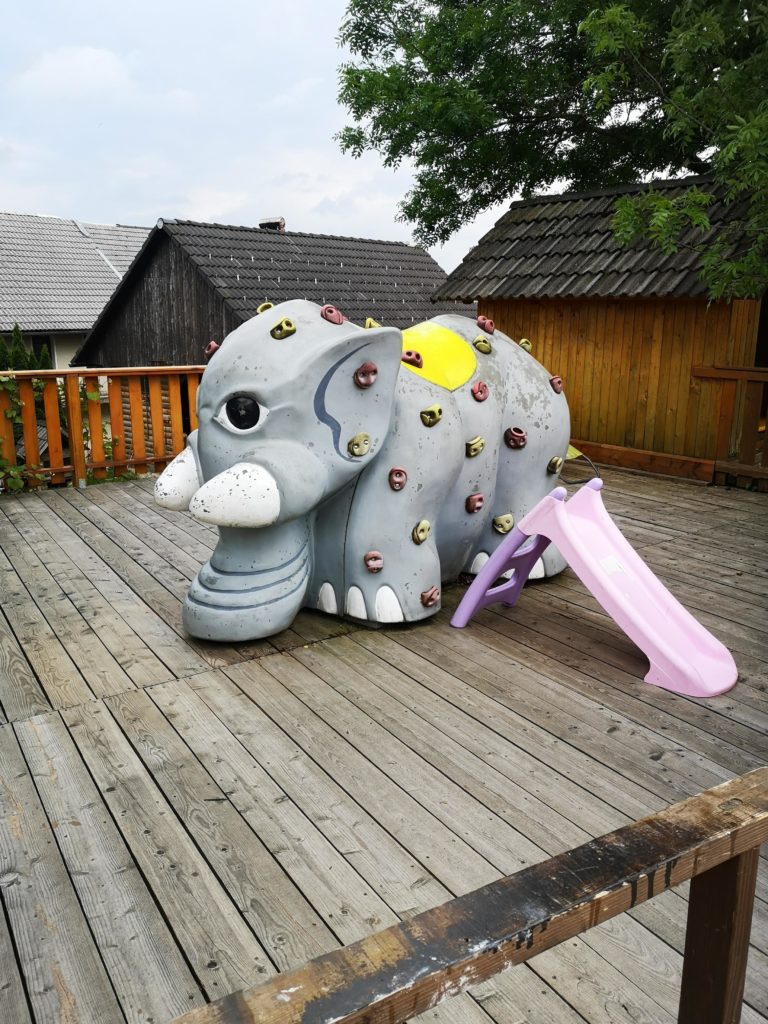
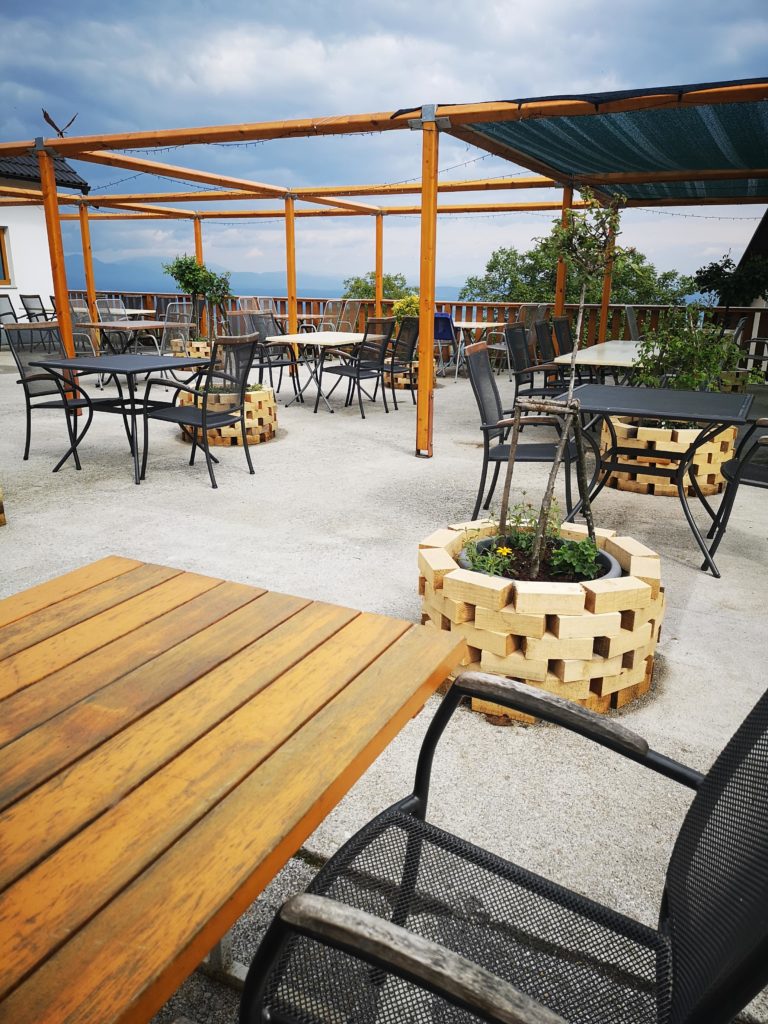
An excellent traditional restaurant, in the countryside, off the beaten track with a beautiful panoramic terrace and children’s games (ideal for families). Perfect for lunch or dinner.
Gostilna, Pri Bostjanu : Krizna gora 8a – 4220 Skofja Loka
Skofja Loka, a pretty medieval village
On the way back, you’ll pass through Skofja Loka, a pretty village with a large rectangular square, two old streets and a castle.
- Park in the car parks at Kapucinski trg 7 ( Google Maps location here),
- Cross the Kamniti most bridge over the river Sora. You can see it from the car park.
- Reach the old centre.
- Wander around the old streets for 20 minutes. You will naturally find the most beautiful streets. No need for a guide or more advice.
- Have a coffee. In the summer, you can have a drink there in the evening.
I haven’t recommended this village on the blogyet because, although it’s very pretty, it’s not the kind of holiday I’d recommend in Slovenia. Parking, wandering around a village and getting back in your car 30 minutes later.
